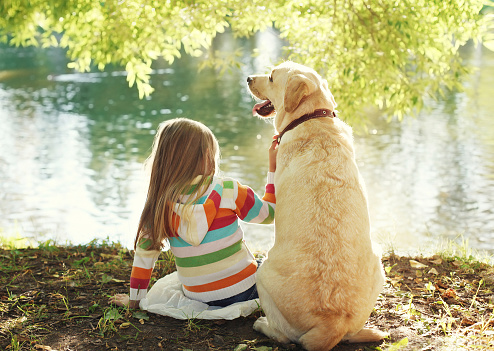River And Lake Safety

Summer will be fast approaching and as the temperature warms many of us will be headed out to lakes and rivers to hike or just cool off and enjoy the summer weather. This is also a chance to spend some quality time and have fun with the family dog. While this can be an enjoyable way to spend the day, there are some safety measures that should be followed.
Introduce Slowly
Introduce dogs to the water slowly. Let them go in at their own pace. The old “throw them in”, method does not work and will only serve to make your dog afraid of the water. Take it slow and make the experience fun for them, no matter what. Realize that some dogs, like some people, may never enjoy the water. Short legged, dense bodied dogs such as Pugs and Bulldogs cannot swim because their bodies are not designed to.
Life Jacket
If your dog is new to swimming, a life jacket is an excellent idea. This can provide buoyancy while your dog learns to swim well. Life jackets are also a good idea for dogs that will spend much of the day in the water. The added buoyancy will keep them from getting over tired and getting into trouble. For dogs that swim in rivers, a life jacket is a must. Dangerous or rapid currents can sweep them away unexpectedly.
Vaccines
Make certain all of your dog’s routine vaccines are current. For dogs that spend a great deal of time in the water, consider vaccinating of Leptospirosis every 6 months. Leptospirosis is a bacterial spirochete found in contaminated water that can cause severe illness and even death. The disease can be carried in the wildlife and rodent population.
Beware of Stagnant Water
Slow flowing lake and river water, especially in late summer, can become stagnant. This may allow for the growth amoeba which, if ingested, can cause brain disease.
Watch for Blue Green Algae
During hot weather, blooms of blue green algae can grow. Ingestion of this algae can be toxic and even fatal.
Snakes and Leaches
Keep an eye out for water moccasins and other poisonous water snakes. They can be found just about anywhere. Make certain your dog is not nosing around holes in riverbanks or lakeshores. If your dog gets bitten, seek veterinary care immediately. Leaches can be found in still water and sluggish streams. They are not a source of disease transmission. If you find a leach on your dog, look for others since leaches tend to be found in groups. To remove a leach, slide a flat object between the leach’s mouthparts, grip the middle of the body and pull. Clean the wound and treat with an antibiotic ointment like you would a scratch.
Fresh Water
Bring fresh water from home for your dog to drink. River or lake water may contain bacteria or Giardia that can cause a gastrointestinal upset.
First Aid Kit
You never know when an accident will happen. Always travel with a pet first aid kit.
Dry Ears and Fur
Wet ears and skin are an invitation to irritation and infection. When your dog is done swimming for the day, dry him off well. If fresh water is available, rise him off well before drying. Use an ear cleaner to rinse out his ears at the end of the day to help prevent ear infection.
Brush Out
Once the hair coat is dry, brush out your pet’s hair coat well, checking for ticks, cuts and other debris.
Hot and Cold
Prolonged time in the sun and water can exhaust a dog to the point of heat stroke. Many dogs do not know when to stop and rest on their own. Make certain your dog takes appropriate rest breaks in the shade. In the spring and fall, the water can be cold enough for overactive dogs to become tired and hypothermic. Seek veterinary care if you see any of the following symptoms.
Heat Stroke or Exhaustion:
- Rapid panting.
- Bright red tongue.
- Red or pale gums.
- Thick, sticky saliva.
- Depression.
- Weakness.
- Dizziness.
- Vomiting – sometimes with blood.
Hypothermia:
- Weakness
- Shivering
- Depressed attitude
- Muscle stiffness
- Shallow, slow breathing
